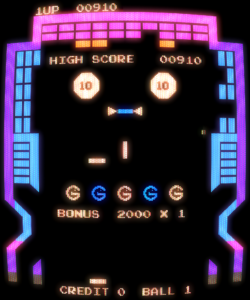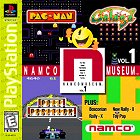
 The Game: Old games never die – they get emulated. Fortunately, one of Japan’s greatest exporters of video game hits has built a museum around several of its most popular titles. With Pac-Man at your side, you wander the corridors of the Namco Museum, where you may examine classic video game sales brochures, promotional items, posters, and the arcade cabinets themselves – which contain, naturally, the actual games. (Namco, 1995)
The Game: Old games never die – they get emulated. Fortunately, one of Japan’s greatest exporters of video game hits has built a museum around several of its most popular titles. With Pac-Man at your side, you wander the corridors of the Namco Museum, where you may examine classic video game sales brochures, promotional items, posters, and the arcade cabinets themselves – which contain, naturally, the actual games. (Namco, 1995)
Memories: A fantastic idea in a so-so package, Namco Museum‘s first volume on the Playstation is a mixture of picture-perfect emulations and a not-so-perfect framing structure. The thought of all the extra material is great in theory – and it has turned out to be one of the “compelling applications” for the DVD format. But in Namco Museum, these nifty ephemera from the 80s are presented to you as exhibits in clumsily bit-mapped hallways and rooms which aren’t even as convincing graphically as the Windows 95 “maze” screen saver.
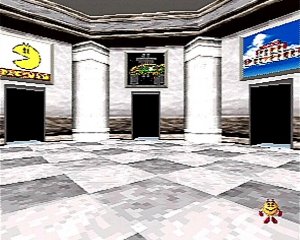 And while I’m fully aware of the fact that Pac-Man, Galaga, Pole Position, Bosconian and others originated in Japan, it’s a little annoying that all of the “exhibits” originate in Japan. Very few of them, if any, have English subtitles or equivalents. I can handle Japanese movies with their original audio and English subtitles, but I can’t read Japanese. So quite a few of the brochures and other items are useless – if almost pretty – to look at. And why is each game’s motherboard on display? There is no accompanying information, just another badly bit-mapped shot of a board with a chipset. If it were up to me, I would have used the otherwise pointless motherboard shots to display information about the processor(s) used, the speed of those chips, and a comparison of how slow those are compared to, say, a Pentium 2 chip or the Motorola 68000 chip that drives the Playstation itself.
And while I’m fully aware of the fact that Pac-Man, Galaga, Pole Position, Bosconian and others originated in Japan, it’s a little annoying that all of the “exhibits” originate in Japan. Very few of them, if any, have English subtitles or equivalents. I can handle Japanese movies with their original audio and English subtitles, but I can’t read Japanese. So quite a few of the brochures and other items are useless – if almost pretty – to look at. And why is each game’s motherboard on display? There is no accompanying information, just another badly bit-mapped shot of a board with a chipset. If it were up to me, I would have used the otherwise pointless motherboard shots to display information about the processor(s) used, the speed of those chips, and a comparison of how slow those are compared to, say, a Pentium 2 chip or the Motorola 68000 chip that drives the Playstation itself.
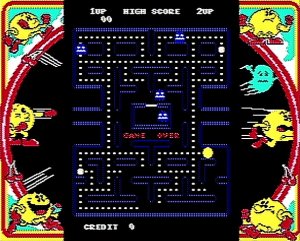 But there are numerous great things about Namco Museum. The emulations are almost perfect, though some of them – which you can see best with the Galaga and Bosconian screen shots here – have been slightly reformatted to, as the disclaimer says, fit your TV. The score and high score displays have, in most cases, been relocated to a sidebar which allows the actual playing field to retain its tall rectangular ratio. An exception to this, sadly, is Pac-Man, which is framed by distracting (and not very good) cartoon character graphics. This is a shame since Pac-Man could have easily been reformatted in the same way as Galaga and Bosconian. And just so you know, this emulation of Pac-Man, annoying border graphics and all, is recycled in Namco’s 20th anniversary Pac-extravaganza Pac-Man World.
But there are numerous great things about Namco Museum. The emulations are almost perfect, though some of them – which you can see best with the Galaga and Bosconian screen shots here – have been slightly reformatted to, as the disclaimer says, fit your TV. The score and high score displays have, in most cases, been relocated to a sidebar which allows the actual playing field to retain its tall rectangular ratio. An exception to this, sadly, is Pac-Man, which is framed by distracting (and not very good) cartoon character graphics. This is a shame since Pac-Man could have easily been reformatted in the same way as Galaga and Bosconian. And just so you know, this emulation of Pac-Man, annoying border graphics and all, is recycled in Namco’s 20th anniversary Pac-extravaganza Pac-Man World.
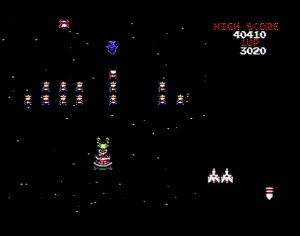 I do have one odd feature to praise, however: the game-specific music. In the badly bit-mapped corridors, you’re treated to a generic new age drone so drowsy, it’d put Yanni to sleep. But once you enter the area containing the arcade cabinet, you’re treated to a new rendition of that game’s musical theme or themes. Though it’s not like John Williams composed the high score screen music from Pole Position, and Galaga‘s fighter capture tune isn’t going to be compared to Mozart anytime soon, someone turned these catchy little
I do have one odd feature to praise, however: the game-specific music. In the badly bit-mapped corridors, you’re treated to a generic new age drone so drowsy, it’d put Yanni to sleep. But once you enter the area containing the arcade cabinet, you’re treated to a new rendition of that game’s musical theme or themes. Though it’s not like John Williams composed the high score screen music from Pole Position, and Galaga‘s fighter capture tune isn’t going to be compared to Mozart anytime soon, someone turned these catchy little  barely-a-song snippets into fantastic, more fully-orchestrated suites which really keep the original flavor, but add a little more music density. Don’t go stampeding straight to the machine – walk around the room, and listen to the music. Chances are you’ll hear something from your adolescence that has been buried in your gaming consciousness for years.
barely-a-song snippets into fantastic, more fully-orchestrated suites which really keep the original flavor, but add a little more music density. Don’t go stampeding straight to the machine – walk around the room, and listen to the music. Chances are you’ll hear something from your adolescence that has been buried in your gaming consciousness for years.

